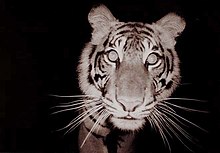Camera trap

A camera case or wild camera is a camera provided with a motion detector , an infrared - sensor or a light barrier is provided.
use
Camera traps are used, for example, to record wild animals both in the context of hunting and in biological field research . They are important instruments in studies of the breeding behavior of birds, rare and nocturnal species, the size of populations and their habitat use . For this purpose, camera traps are placed in places where wild animals are likely to visit, such as along game passages . As soon as the sensor detects the presence of an animal, a photo is triggered without disturbing the wild animal.
In addition, camera traps are also used for general surveillance.
history
A pioneer in camera trap development was Frederick Walter Champion . In the Sivalik Hills in northern India , he used cameras that were triggered by tripwires to record wildlife. Using this technique, he obtained remarkable recordings, among the earliest of wild Bengal tigers , Indian leopards , sloth bears and Indian wild dogs .
field research
It was only at the beginning of the 1990s that the concept of using camera traps in field research on tigers was further developed. These models consisted of a camera with a wide-angle lens , a flash , a solar panel, and a pressure-sensitive mat. The solar panel was placed as high as possible in a tree to power the flash, which was placed a few meters away from the camera. The mat attached to the camera was buried about 1 cm deep in the ground, covered with leaves and adjusted so that the camera was only triggered if an animal heavier than 5 kg stepped on it.
Just a few years later, the first camera traps with infrared heat sensors were tested in field research, but these only provide useful results at cool temperatures, when the body temperature of the animals being examined is significantly higher than the temperature of the environment.
In the meantime, a distinction is essentially made between automatic and self-triggering camera traps. Automatic systems include cameras that are programmed to trigger continuously or at specific intervals. They are mainly used in behavioral studies of birds, but have also become very popular as webcams . In contrast, self-triggering cameras are inactive until an event triggers a recording. The trigger setting is either mechanical or infrared. Active infrared-controlled camera traps emit a continuous beam of light which, when interrupted, triggers the image. Passive infrared-controlled camera traps have two sensors mounted next to each other that measure movement and temperature and trigger the image when the measured values change.
costs
Camera traps are available from 50 euros. The installed equipment is occasionally damaged or stolen, causing the scientists considerable financial damage and losing valuable data. Newer devices are therefore provided with lockable metal housings and specially fastened to prevent theft and damage. In addition, housings are offered that are colored in camouflage colors, protect against moisture and are insulated so that the click of the camera shutter cannot be heard.
Individual evidence
- ↑ a b c D. E. Swann, K. Kawanishi, J. Palmer: Evaluating Types and Features of Camera Traps in Ecological Studies: A Guide for Researchers . In: Allan F. O'Connell, James D. Nichols, Ullas K. Karanth (Eds.): Camera Traps in Animal Ecology: Methods and Analyzes. Springer, 2010, ISBN 978-4-431-99494-7 , pp. 27-43.
- ↑ FW Champion: With a Camera in Tiger Land. Chatto & Windus, London 1927.
- ↑ A. Rafiastanto: Camera trapping survey of Javan tiger and other wild animals in Meru Betiri National Park. WWF-IP Project ID 0084-02, Jakarta 1994.
- ^ R. Boonstra, CJ Krebs, S. Boutin, JM Eadie: Finding mammals using far-infrared thermal imaging (PDF; 130 kB). In: Journal of Mammalogy . 75 (4), 1994, pp. 1063-1068.
- ↑ Search result on Amazon.de for: camera trap. Retrieved November 1, 2019 .
- ↑ CM Fiehler, BL Cypher, S. Bremner-Harrison, D. Pounds: A Theft-Resistant Adjustable Security Box for Digital Cameras. In: Journal of Wildlife Management. 71 (6), 2007, pp. 2077-2080.
literature
- Allan F. O'Connell, James D. Nichols, K. Ullas Karanth: Camera Traps in Animal Ecology. Methods and Analyzes. Springer Tokyo / Dordrecht / Heidelberg / London / New York 2011, ISBN 978-4-431-99495-4 .
- J. Brown, SD Gehre: The Basics of Using Remote Cameras to Monitor Wildlife (PDF; 926 kB). Fact Sheet of Agriculture and Natural Resources, The Ohio State University, 2009.
- M. Yasuda: Monitoring diversity and abundance of mammals with camera traps: a case study on Mount Tsukuba, central Japan. In: Mammal Study. 29, 2004, pp. 37-46.
- TL Cutler, DE Swann: Using remote photography in wildlife ecology: a review. In: Wildlife Society Bulletin. 27, 1999, pp. 571-581.
- F. Rovero, F. Zimmermann (Eds.): Camera Trapping for Wildlife Research . Pelagic Publishing, Exeter 2016, ISBN 978-1-78427-048-3 .
Web links
- Smithsonian Wild: 201,000 Camera Trap Images (in English)



